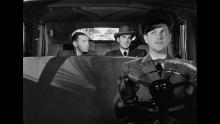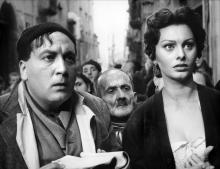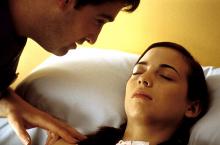These notes on Arthur Ripley's The Chase (1946) were written by Zachary Zahos, PhD candidate in UW Madison’s Department of Communication Arts. A 35mm print of The Chase will screen on Sunday, January 28 as the first in our Sunday Cinematheque at the Chazen series inspired by Professor David Bordwell's new book, Reinventing Hollywood: How 1940s Filmmakers Changed Movie Storytelling. The free screening will be preceded by a one-hour lecture from Professor Bordwell at 2 p.m. in the auditorium at the Chazen Museum of Art. The print of The Chase comes courtesy of the UCLA Film & Television Archive. Restoration funding provided by The Film Foundation and the Franco-American Cultural Fund.'
By Zachary Zahos
No less strange eight decades removed, The Chase (1946) confounds from all angles. Unlike other famously confusing noirs like The Big Sleep, The Chase keeps the gears of its plot spinning front and center, hinging on a spectacular twist. The set-up is simple enough: WWII veteran Chuck Scott (Robert Cummings, also the wrong man in Hitchcock’s Saboteur) chauffeurs for Miami criminal Eddie Roman (Steve Cochran), only to fall for his wife, Lorna (Michèle Morgan, from Port of Shadows) and flee with her to Havana. Toward the film’s end, however, Chuck seemingly gains the ability of second sight, and the story’s conflicts resolve through coincidences and ironic twists of fate. Throughout The Chase, an aura of unrest and impossibility permeates the surprising turns, sinister performances, baroque sets, uneasy pauses—the very fabric of the film.
UW-Madison’s Professor David Bordwell, who introduces Sunday’s Chazen screening, has demystified The Chase’s unusual narrative structure in recent years. In two 2016 blog posts and his new book, Reinventing Hollywood: How 1940s Filmmakers Changed Movie Storytelling, Bordwell situates The Chase within the dramatic trends of its time. But if earlier, successful films like Spellbound and The Woman in the Window indulged respectively in amnesia and it-was-all-a-dream tropes, then The Chase distinguished itself as one of the few to join the two devices at the hip. Furthermore, Bordwell cites studio correspondence, novelizations, and an early script tucked away in the Munich Film Museum to illuminate how, in the process of trying to meet producer Seymour Nebenzal’s request to slap a happy ending onto Cornell Woolrich’s source material, The Black Path of Fear, screenwriter Philip Yordan first devised an even more disorienting plot structure. The rushed final product beguiles in part because Nebenzal, Yordan, and director Arthur Ripley apparently worked toward a compromise that was somehow both neater and still rife with loose ends.
As fascinating as its plot is, The Chase also compels on stylistic grounds alone. With roughly half the action in Miami and the rest in Havana, Ripley, art director Robert Usher, and set decorator Victor Gangelin (who also worked on The Searchers) collaborated on a dreamy, suggestive mise-en-scène. Compare Eddie Roman’s absurd Miami mansion, with its classical sculptures and cherubs guarding its front door peepholes, to the oriental statues filling the Cuban curio store owned by Madame Chin, played by Russian opera singer and Rachmaninoff muse Nina Koshetz. While critics this century have drawn connections between The Chase’s plot and David Lynch projects like Lost Highway, the attention paid to enigmatic, artisan props—like the jade-handled knives sold by Chin—surpasses conventional use of the MacGuffin and approaches totemic, Lynchian abstraction.
Even light itself regularly assumes an intimidating sense of agency. Surely cinematographer Franz Planer labored to get the timing of the falling and cresting of light over Chuck and Lorna’s porthole, during their boat ride to Cuba, just right. Not long after, in a Havana nightclub, a photographer’s flash syncs with a moment of fatal stabbing—predating the flash-bulb-as-weapon climax of Rear Window (another Woolrich adaptation) by eight years. Earlier in the film, the gorgeous rear projection of waves crashing against a pier appears twice, and the contrast in lighting between them subverts expectations: nighttime for Lorna and Chuck’s stolen moment, and bright daylight when Eddie, backed by henchman Gino (Peter Lorre), needles Chuck about his feelings for his wife.
Steve Cochran, as Eddie, and Lorre as Gino deliver the most nuanced performances in the film, and together establish much of The Chase’s unsettling atmosphere. Introduced as a disembodied eye and voice through one of the cherub peepholes, Lorre soon proves his abilities as a master of on-screen business: In one gap between lines, Lorre wields a nail file, bites his nail, spits, and pulls back to take a drag from a cigarette. In contrast, Cochran at times lowers his voice to a whisper and restricts all movement to a panther-like stillness—during these moments he shoots an unblinking glare that is terrifying. Cochran projects an aggressive virility that, underneath the attractive surface, is the source of Eddie’s power, and the audience’s fear of that power. He is the kind of proto-Bond (and post-Freud) villain who installs a set of back-seat pedals to override his own driver, simply to assert his dominance. That Eddie spends a key scene of crisis lazing on a couch, only offering Gino cryptic orders (“Play the other side.”), adds a banal and unpredictable layer to his evil.
With Eddie so cruel a character, The Chase ranks among the more sadistic of film noirs. After all, the film introduces Eddie with him assaulting a woman and leaving blood. Later, too, he locks a rival (Lloyd Corrigan) in his wine cellar and feeds him to his dog, whereupon the shattering of a bottle of vintage Napoleon brandy vividly stands for the off-screen ravaging. For these reasons and more (including the uninflected central relationship between Chuck and Lorna), The Chase remains a troubling, flawed work—though it is telling how many of the “neo-noirs” from the late 20th century to the present have since doubled down on these unsavory elements. In the dual contexts of its time and ours today, The Chase sells a bold narrative gamble with brio, downplaying sense—and with it meaning—in favor of pure evocation.










